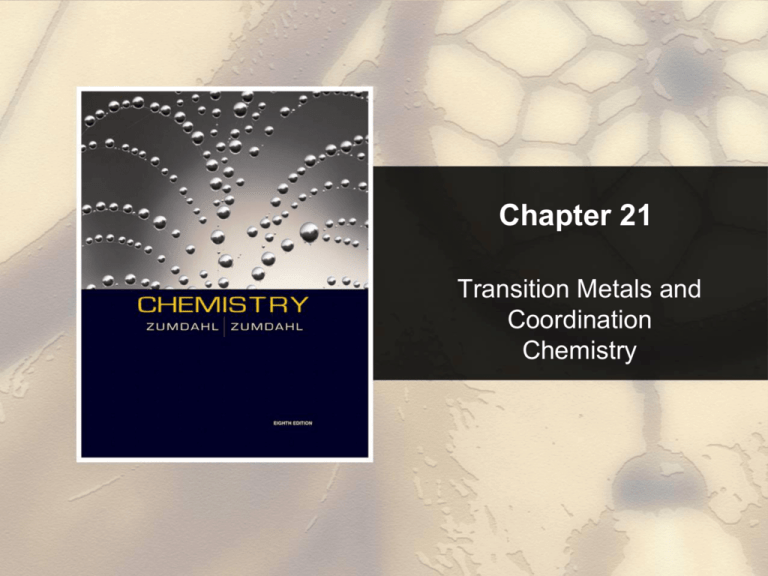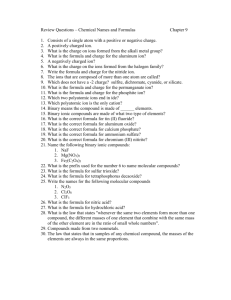
Chapter 21
Transition Metals and
Coordination
Chemistry
Section 21.1
The Transition Metals: A Survey
The Position of the Transition Elements on the Periodic Table
Return to TOC
Copyright © Cengage Learning. All rights reserved
2
Section 21.1
The Transition Metals: A Survey
Forming Ionic Compounds
• More than one oxidation state is often found.
• Cations are often complex ions – species where
the transition metal ion is surrounded by a
certain number of ligands (Lewis bases).
Return to TOC
Copyright © Cengage Learning. All rights reserved
3
Section 21.1
The Transition Metals: A Survey
The Complex Ion Co(NH3)63+
Return to TOC
Copyright © Cengage Learning. All rights reserved
4
Section 21.1
The Transition Metals: A Survey
Ionic Compounds with Transition Metals
• Most compounds are colored because the
transition metal ion in the complex ion can
absorb visible light of specific wavelengths.
• Many compounds are paramagnetic.
– is a form of magnetism whereby the
substance is only attracted when in the
presence of an induced magnetic field.
Return to TOC
Copyright © Cengage Learning. All rights reserved
5
Section 21.1
The Transition Metals: A Survey
Electron Configurations
• Example
V: [Ar]4s23d3
• Exceptions: Cr and Cu
Cr: [Ar]4s13d5
Cu: [Ar]4s13d10
Return to TOC
Copyright © Cengage Learning. All rights reserved
6
Section 21.1
The Transition Metals: A Survey
Electron Configurations
• First-row transition metal ions do not have 4s
electrons.
Energy of the 3d orbitals is less than that of
the 4s orbital.
Ti: [Ar]4s23d2
Ti3+: [Ar]3d1
Return to TOC
Copyright © Cengage Learning. All rights reserved
7
Section 21.1
The Transition Metals: A Survey
Lanthanide Contraction
• Electrons fill the 4f orbitals
• 4f orbitals are buried in the interior
of the atom
• As electrons are added to the
buried 4f, the atomic size does not
increase
• The atomic radii decreases due to
increase nuclear charge
• Notice similar radii for 4d and 5d
elements (green & red)
Return to TOC
Copyright © Cengage Learning. All rights reserved
8
Section 21.3
The Mole
Coordination
Compounds
A Coordination Compound
• Typically consists of a complex ion and
counterions (anions or cations as needed to
produce a neutral compound):
[Co(NH3)5Cl]Cl2
[Fe(en)2(NO2)2]2SO4
K3Fe(CN)6
Return to TOC
Copyright © Cengage Learning. All rights reserved
9
Section 21.3
The Mole
Coordination
Compounds
Coordination Number
• Number of bonds formed between the metal ion
and the ligands in the complex ion.
6 and 4 (most common)
2 and 8 (least common)
Return to TOC
Copyright © Cengage Learning. All rights reserved
10
Section 21.3
The Mole
Coordination
Compounds
Ligands
• Neutral molecule or ion having a lone electron
pair that can be used to form a bond to a metal
ion.
Monodentate ligand – one bond to a metal
ion
Bidentate ligand (chelate) – two bonds to a
metal ion
Polydentate ligand – more than two bonds to
a metal ion
Return to TOC
Copyright © Cengage Learning. All rights reserved
11
Section 21.3
The Mole
Coordination
Compounds
[Co(NH3)5
2Cl]
AND /
OR
Return to TOC
Copyright © Cengage Learning. All rights reserved
12
Section 21.3
The Mole
Coordination
Compounds
Coordinate Covalent Bond
• Bond resulting from the interaction between a Lewis
acid (the metal ion) and a Lewis base (the ligand).
[Co(NH3)5Cl]Cl2
Return to TOC
Copyright © Cengage Learning. All rights reserved
13
Section 21.3
The Mole
Coordination
Compounds
Rules for Naming Coordination Compounds
[Co(NH3)5Cl]Cl2
1. Cation is named before the anion.
“chloride” goes last (the counterion)
2. Ligands are named before the metal ion.
ammonia (ammine) and chlorine (chloro) named
before cobalt
Return to TOC
Copyright © Cengage Learning. All rights reserved
14
Section 21.3
The Mole
Coordination
Compounds
Rules for Naming Coordination Compounds
[Co(NH3)5Cl]Cl2
3. For negatively charged ligands, an “o” is added
to the root name of an anion (such as fluoro,
bromo, chloro, etc.).
4. The prefixes mono-, di-, tri-, etc., are used to
denote the number of simple ligands.
pentaammine
Return to TOC
Copyright © Cengage Learning. All rights reserved
15
Section 21.3
The Mole
Coordination
Compounds
Rules for Naming Coordination Compounds
[Co(NH3)5Cl]Cl2
5. The oxidation state of the central metal ion is
designated by a Roman numeral:
cobalt (III)
6. When more than one type of ligand is present,
they are named alphabetically:
pentaamminechloro
Return to TOC
Copyright © Cengage Learning. All rights reserved
16
Section 21.3
The Mole
Coordination
Compounds
Rules for Naming Coordination Compounds
[Co(NH3)5Cl]Cl2
7. If the complex ion has a negative charge, the
suffix “ate” is added to the name of the metal.
The correct name is:
pentaamminechlorocobalt(III) chloride
Return to TOC
Copyright © Cengage Learning. All rights reserved
17
Section 21.3
The Mole
Coordination
Compounds
Exercise
Name the following coordination compounds.
a) [Co(H2O)6]Br3 hexaaquacobalt(III) bromide
b) Na2[PtCl4]
sodiumtetrachloro-platinate(II)
Return to TOC
Copyright © Cengage Learning. All rights reserved
18
Section 21.5
Bonding in Complex Ions: The Localized Electron Model
Bonding in Complex Ions
1. The VSEPR model for predicting structure
generally does not work for complex ions.
However, assume a complex ion with a
coordination number of 6 will have an
octahedral arrangement of ligands.
And, assume complexes with two ligands will
be linear.
But, complexes with a coordination number
of 4 can be either tetrahedral or square
planar.
Return to TOC
Copyright © Cengage Learning. All rights reserved
19
Section 21.6
The Crystal Field Model
Complex Ion Colors
• When a substance absorbs certain wavelengths
of light in the visible region, the color of the
substance is determined by the wavelengths of
visible light that remain.
Substance exhibits the color complementary
to those absorbed.
Return to TOC
Copyright © Cengage Learning. All rights reserved
20








